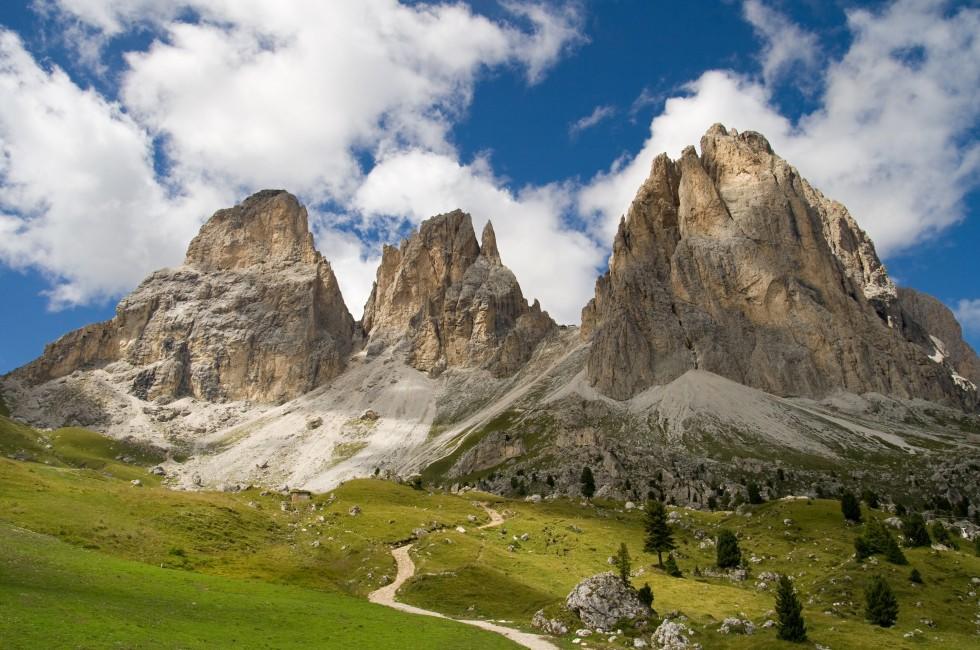The Dolomites
The Dolomites
The Dolomites, those inimitable craggy peaks Le Corbusier called "the most beautiful work of architecture ever seen," are never so arresting as at dusk, when the last rays of sun create a pink hue that languishes into purple—a magnificent transformation locals call the enrosadira. You can certainly enjoy this glow from a distance, but the Dolomites are such an appealing year-round destination precisely because of the many ways to get into the mountains themselves. And once there, in short order your perspective—like the peaks around you—will become a rosy hue.
The Dolomites are strange, rocky pinnacles that jut straight up like chimneys; they are, in fact, the otherworldly pinnacles that Leonardo depicted in the background of his Mona Lisa. In spite of this incredibl...
Read MoreThe Dolomites, those inimitable craggy peaks Le Corbusier called "the most beautiful work of architecture ever seen," are never so arresting as at dusk, when the last rays of sun create a pink hue that languishes into purple—a magnificent transformation locals call the enrosadira. You can certainly enjoy this glow from a distance, but the Dolomites are such an appealing year-round destination precisely because of the many ways to get into the mountains themselves. And once there, in short order your perspective—like the peaks around you—will become a rosy hue.
The Dolomites are strange, rocky pinnacles that jut straight up like chimneys; they are, in fact, the otherworldly pinnacles that Leonardo depicted in the background of his Mona Lisa. In spite of this incredible beauty, the vast mountainous domain of northeastern Italy has remained relatively undeveloped. Below the peaks, rivers meander through valleys dotted with peaceful villages, while pristine lakes are protected by picture-book castles. In the most secluded Dolomite vales, unique cultures have flourished: the Ladin language, an offshoot of Latin still spoken in the Val Gardena and Val di Fassa, owes its unlikely survival to centuries of topographic isolation.
The more accessible parts of Trentino–Alto Adige, on the other hand, have a history of near-constant intermingling of cultures. The region's Adige and Isarco valleys make up the main access route between Italy and Central Europe, and as a result, the language, cuisine, and architecture are a blend of north and south. The province of Trentino is largely Italian-speaking, but Alto Adige is predominantly Germanic: until World War I the area was Austria's Südtirol. As you move north toward the famed Brenner Pass—through the prosperous valley towns of Rovereto, Trento, and Bolzano—the Teutonic influence is increasingly dominant; by the time you reach Bressanone, it's hard to believe you're in Italy at all.
Recommended Fodor’s Video
Hotels
Things to Do
Things to Do
Explore Things to Do
Find the perfect tours and activities in The Dolomites.
Where to Eat
Where to Eat
Need to Know
Need to Know
Language
ItalianNearby Airports
BZOElectrical Outlets
200v/50 cycles; electrical plugs have two round prongsCurrency
EuroLanguage
ItalianElectrical Outlets
200v/50 cycles; electrical plugs have two round prongsCurrency
EuroNearby Airports
BZONeighborhood Guides
Discover the best neighborhoods in The Dolomites with curated recommendations from our editors.
essentials
transportation
Neighborhood Guides
Discover the best neighborhoods in The Dolomites with curated recommendations from our editors.
Neighborhood Guides
Discover the best neighborhoods in The Dolomites with curated recommendations from our editors.
essentials
transportation
Articles
Articles See All
Guidebooks
Guidebooks
Our worldwide travel correspondents bring you the best and most up-to-date coverage of over 7,500 global destinations.
Shop NowFodor's Essential Italy 2024
For over 80 years, Fodor's Travel has been a trusted resource offering expert travel...
Fodor's Best of Italy: Rome, Florence, Venice & the Top Spots in Between
Whether you want to visit the Colosseum in Rome, go designer shopping in Milan, or take a...
















